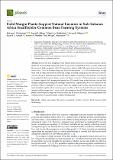| dc.description.abstract | Flower-rich field margins provide habitats and food resources for natural enemies of pests
(NEs), but their potential, particularly in the tropics and on smallholder farms, is poorly understood.
We surveyed field margins for plant-NE interactions in bean fields. NEs most often interacted with
Bidens pilosa (15.4% of all interactions) and Euphorbia heterophylla (11.3% of all interactions). In cage
trials with an aphid-infested bean plant and a single flowering margin plant, the survival of Aphidius
colemani, the most abundant parasitoid NE in bean fields, was greater in the presence of Euphorbia
heterophylla than Bidens pilosa, Tagetes minuta, and Hyptis suaveolens. UV-fluorescent dye was applied
to flowers of specific field margin plant species and NE sampled from within the bean crop and field
margins using sweep-netting and pan-traps respectively. Captured insects were examined for the
presence of the dye, indicative of a prior visit to the margin. Lady beetles and assassin bugs were
most abundant in plots with B. pilosa margins; hoverflies with T. minuta and Parthenium hysterophorus
margins; and lacewings with T. minuta and B. pilosa margins. Overall, NE benefitted from field margin
plants, and those possessing extra floral nectaries had an added advantage. Field margin plants need
careful selection to ensure benefits to different NE groups. | en_US |

